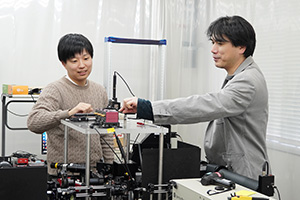

12/09/2024

Recent observations of spin currents (SCs) generated via different mechanisms in different materials have raised important questions: do these mechanisms lead to SCs with distinct properties, and if so, can their relative pros and cons be teased out?
“Both helicity-dependent photocurrent via photon-spin conversion and spin-charge conversion in Bi thin films have been reported recently,” explains Kazuaki Ishibashi, a member of the AIMR research team. “However, because the two SC-generation mechanisms occur simultaneously during photocurrent measurements, isolating and studying photon-spin conversion alone has been impossible.”
In a recent article, Ishibashi, Mizukami and co-workers addressed this challenge by designing a Bi/Co bilayer system that supports both SC-generation mechanisms, enabling direct comparison of the generated SCs on the same sample for the first time1.
Using either circularly or linearly polarized light exclusively on Bi/Co samples, the team analyzed the respective SC THz signals with a custom-made THz time-domain spectroscopy with Ti: Sapphire laser2, allowing them to separately study the contributions from Co demagnetization and from photon-spin conversion—including the helicity-dependent THz emission induced by the latter mechanism.
“Our approach enabled us to compare how the SC-generation mechanisms affect key SC properties, such as relaxation times,” says Ishibashi. “By investigating the thickness dependence of the Bi layer in the Bi/Co bilayers, we determined that SCs generated by photon-spin conversion exhibit significantly longer relaxation times.”
Currently, the team is using this approach to study helicity-dependent THz emission in other Bi-like metals with high spin-orbit coupling properties.
(Author: Patrick Han)
This research highlight has been approved by the authors of the original article and all information and data contained within has been provided by said authors.